Discover 35 hidden attractions, cool sights, and unusual things to do in Düsseldorf (Germany). Don't miss out on these must-see attractions: Rheinturm, Altstadt, and Schloss Benrath. Also, be sure to include Kunstsammlung Nordrhein-Westfalen in your itinerary.
Below, you can find the list of the most amazing places you should visit in Düsseldorf (North Rhine-Westphalia).
Table of Contents
Rheinturm
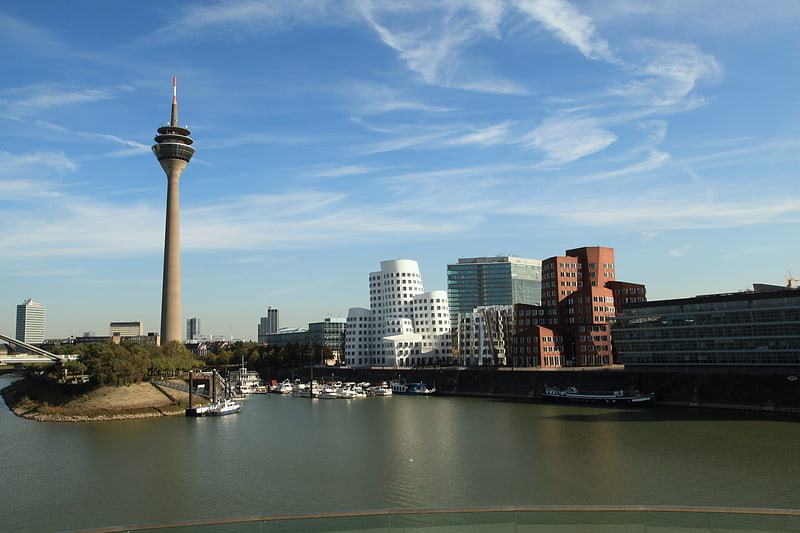
Tower in Düsseldorf, Germany. The Rheinturm is a 240.5-metre-high concrete telecommunications tower in Düsseldorf, capital of the federal state of North Rhine-Westphalia, Germany. Construction commenced in 1979 and finished in 1981. The Rheinturm carries aerials for directional radio, FM and TV transmitters. It stands 174.5 metres high and houses a revolving restaurant and an observation deck at a height of 170 metres. It is the tallest building in Düsseldorf.
The Rheinturm was inaugurated on 1 December 1981. It contains 7,500 cubic metres of concrete and weighs 22,500 tons. Before October 15, 2004, when an aerial antenna for DVB-T was mounted, it was 234.2 metres high.
The observation deck is open to public daily from 10:00 to 23:30. As a special attraction, a light sculpture on its shaft works as a clock. This sculpture was designed by Horst H. Baumann and is called Lichtzeitpegel (light time level). The light sculpture on the Rheinturm is the largest digital clock in the world.[1]
Address: Stromstraße 20, 40221 Düsseldorf (Stadtbezirke 03)
Altstadt
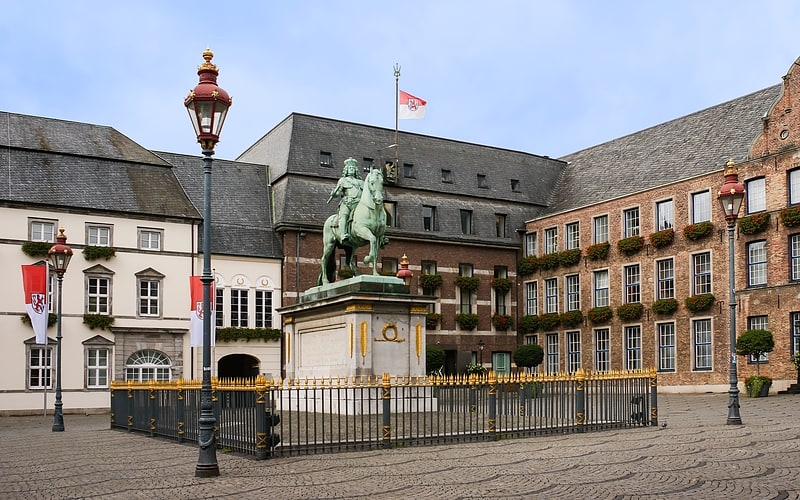
The Altstadt is one of the 49 boroughs of Düsseldorf, Germany; it belongs to central City District 1. The Düsseldorfer Altstadt is known as "the longest bar in the world", because the small Old Town has more than 300 bars and discothèques; supposedly, each establishment's bar-counter connecting to one next door.
Düsseldorf is famed for its special beer, Altbier ("old beer"), brewed from an old traditional recipe, which is only produced in a few places in the world since the end of the 19th century.
The Old Town has an area of half a square kilometer (which is less than a quarter of a percent of the whole city) and has 2297 inhabitants (2000), less than half a percent of the population of Düsseldorf. The density of population is thus 4594 inhabitants/km2.[2]
Schloss Benrath
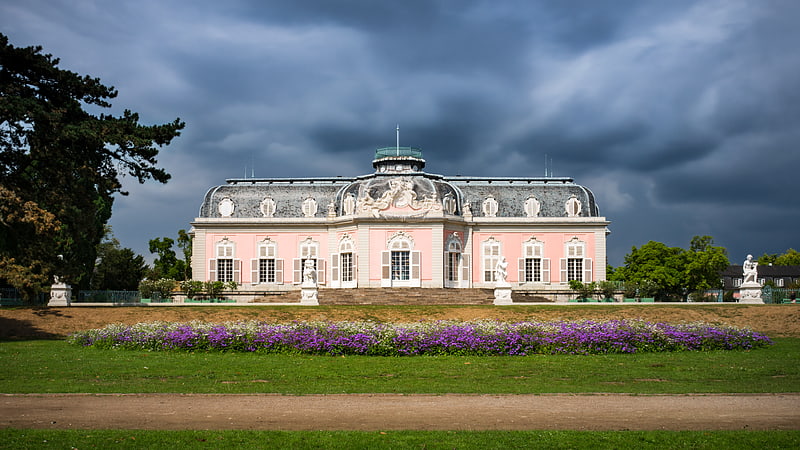
18th-century palace with museum and events. Schloss Benrath is a Baroque-style maison de plaisance in Benrath, which is now a borough of Düsseldorf. It was erected for the Elector Palatine Charles Theodor and his wife, Countess Palatine Elisabeth Auguste of Sulzbach, by his garden and building director Nicolas de Pigage. Construction began in 1755 and was completed in 1770. The ensemble at Benrath has been proposed for designation as a UNESCO World Heritage Site.[3]
Address: Benrather Schlossallee 100-106, 40597 Dusseldorf (Stadtbezirke 09)
Kunstsammlung Nordrhein-Westfalen
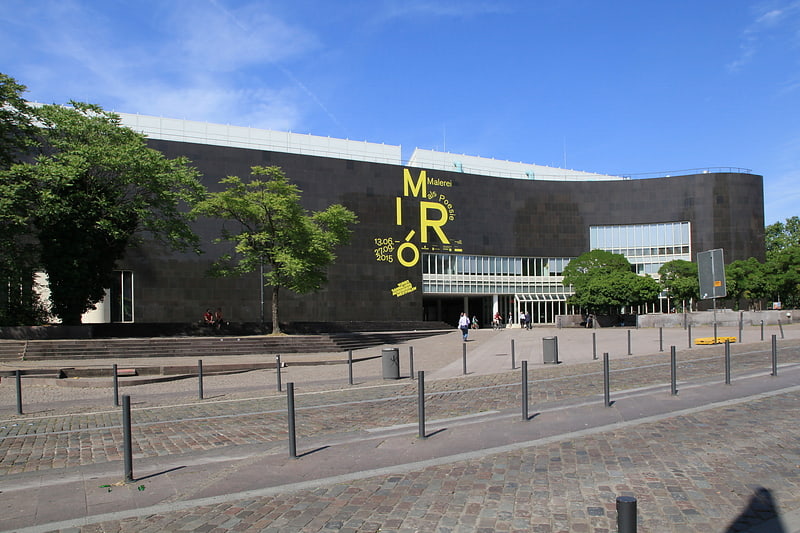
Art institute in Düsseldorf, Germany. The Kunstsammlung Nordrhein-Westfalen is the art collection of the German Federal State of North Rhine-Westphalia, in Düsseldorf. United by this institution are three different exhibition venues: the K20 at Grabbeplatz, the K21 in the Ständehaus, and the Schmela Haus. The Kunstsammlung was founded in 1961 by the state government of North Rhine-Westphalia as a foundation under private law for the purpose of displaying the art collection and expanding it through new acquisitions.
During its 50-year history, the Kunstsammlung Nordrhein-Westfalen has earned an international reputation as a museum for the art of the 20th century. For some time now, however, the chronological spectrum of the collection—which was initiated through the purchase of works by Paul Klee—has extended up to the immediate present. The building at Grabbeplatz (K20), with its characteristic black granite façade, was inaugurated in 1986. An extension building was completed in 2010.
With major works by Pablo Picasso, Henri Matisse, and Piet Mondrian, among others, as well as a wide-ranging ensemble of circa 100 drawings and paintings by Paul Klee, the permanent collection of the Kunstsammlung offers a singular perspective of classical modernism. The collection of postwar American art includes works by Jackson Pollock and Frank Stella and by pop artists Robert Rauschenberg, Jasper Johns, and Andy Warhol; other high points of the collection are works by Joseph Beuys, Gerhard Richter, Tony Cragg, Emil Schumacher, Sarah Morris, Katharina Fritsch, Nam June Paik, Wolf Vostell and Imi Knoebel.
Opened in spring of 2002 as an additional venue of the Kunstsammlung was the Ständehaus (K21) set alongside the Kaiserteich, a building which formerly served as the seat of the Parliament of North Rhine-Westphalia. Among the highlights on view there are a number of artist's rooms and large-scale installations, a special focus of this portion of the collection.
The Schmela Haus, in Düsseldorf's historic district, joined the Kunstsammlung in 2009 as a "rehearsal stage" and lecture venue. When it first opened in 1971, this protected landmark by Dutch architect Aldo van Eyck was home to the Galerie Alfred Schmela and was the first building to be erected in the Federal Republic of Germany expressly as an art gallery. Since spring of 2011, the Schmela Haus is also used again for exhibitions.
As an institution with three locations, the Kunstsammlung has more than 10,000 m2 (110,000 sq ft) of exhibition surface at its disposal.
With its accompanying programs and special projects, the Education Department strives to make the works held in the Regional Collection accessible to visitors of all ages. Available for this purpose are a number of studios, a media workshop, and a "laboratory" which is integrated into the exhibition galleries.[4]
Address: Grabbepl. 5, 40213 Düsseldorf (Stadtbezirke 01)
Landtag Nrw
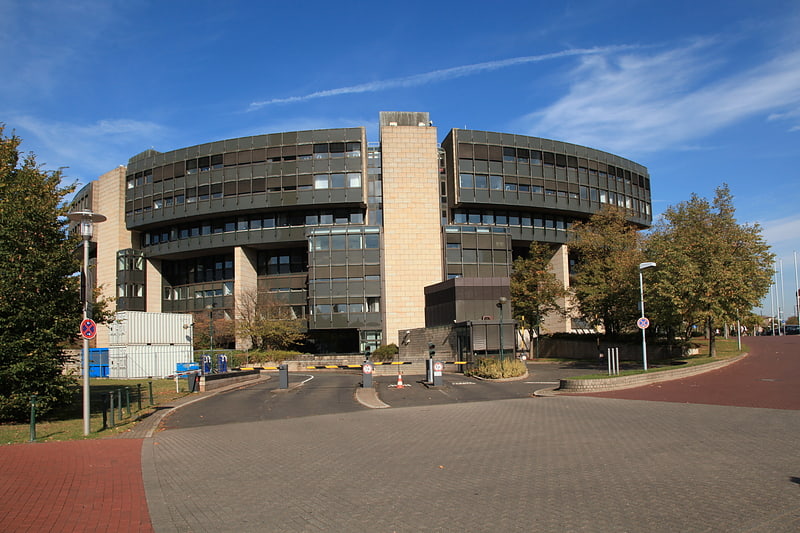
Also known as: Landtag Nordrhein-Westfalen
The Landtag of North Rhine-Westphalia is the state parliament of the German federal state of North Rhine-Westphalia, which convenes in the state capital of Düsseldorf, in the eastern part of the district of Hafen. The parliament is the central legislative body in the political system of North Rhine-Westphalia. In addition to passing of laws, its most important tasks are the election of the Minister-President of the state and the administration of the government. The current parties of government are a coalition of the Christian Democratic Union and the Free Democratic Party, supporting the cabinet of Minister-President Hendrik Wüst since October 2021.
The last state election took place on 14 May 2017.[5]
Address: Hubertusstraße 3, 40219 Düsseldorf (Stadtbezirke 03)
Museum Kunstpalast
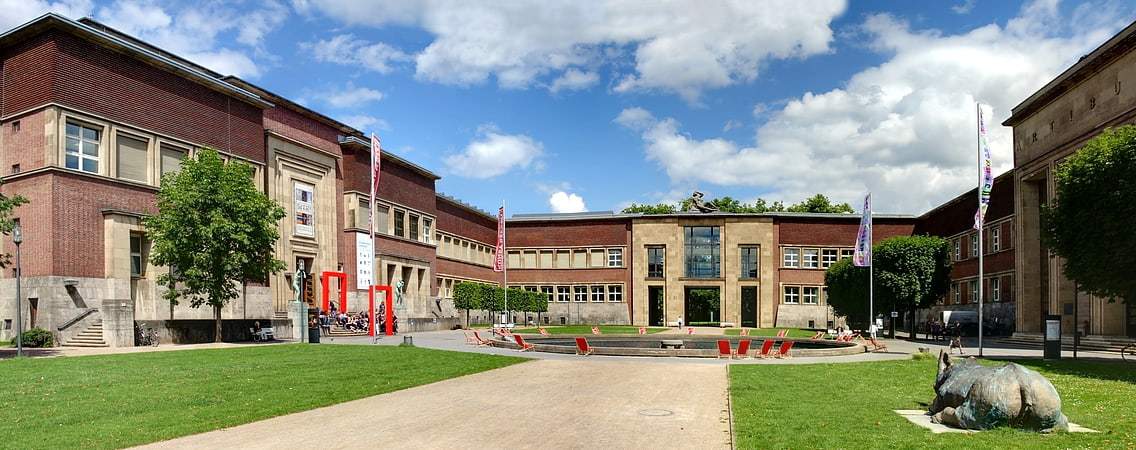
Museum in Düsseldorf, Germany. The Kunstpalast, formerly Kunstmuseum Düsseldorf is an art museum in Düsseldorf.[6]
Address: Ehrenhof 4-5, 40479 Düsseldorf (Stadtbezirke 01)
Esprit Arena

Also known as: Merkur Spiel-Arena
Arena in Düsseldorf, Germany. Merkur Spielarena, previously known as the Esprit Arena, the LTU Arena, and as the Düsseldorf Arena, is a multi-functional football stadium in Düsseldorf, Germany. The stadium holds 54,600 and has a retractable roof. Its special heating system allows the stadium to host comfortable events at the height of winter.[7]
Address: Arena-Str. 1, 40474 Dusseldorf (Stadtbezirke 05)
Kunst im Tunnel
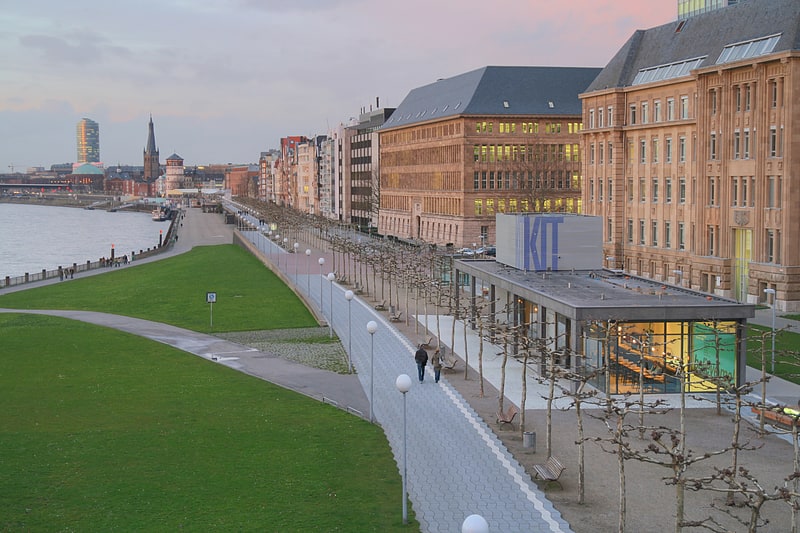
Underground museum of contemporary art. Kunst im Tunnel or KIT is a contemporary art museum in Düsseldorf. It is the new exhibition space of Kunsthalle Düsseldorf, located within the Rheinufertunnel - hence the name. It has an underground exhibition area of 850m².[8]
Address: Mannesmannufer 1b, 40213 Düsseldorf (Stadtbezirke 01)
Botanical garden of Düsseldorf
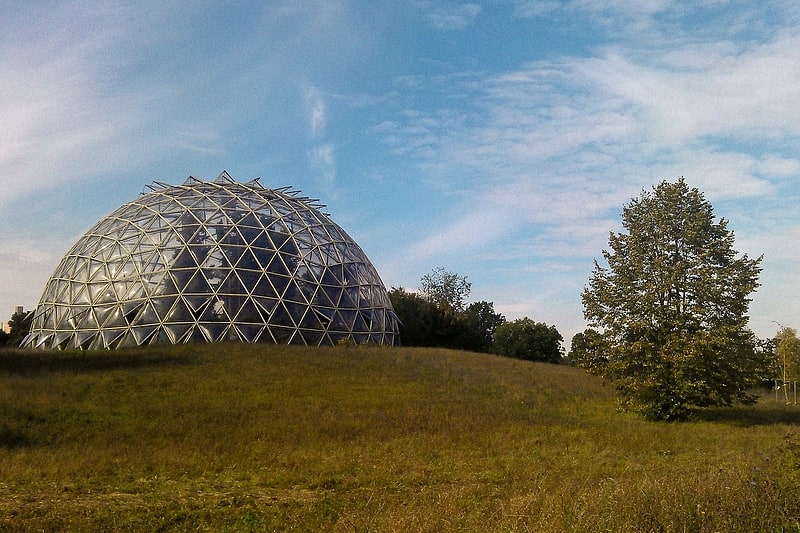
Also known as: Botanischer Garten Düsseldorf
Botanical garden with a dome greenhouse. The Botanischer Garten Düsseldorf, also known as the Botanischer Garten der Heinrich-Heine-Universität Düsseldorf and the Botanischer Garten der Universität Düsseldorf, is a botanical garden of 8 hectares maintained by the University of Düsseldorf. It is located at Universitätsstraße 1, Düsseldorf, North Rhine-Westphalia, Germany, and open daily in the warmer months; admission is free.
The garden was established in 1974 and currently contains about 6000 species, with a focus on plants of temperate climates. Its outdoor gardens are organized as follows:
- Geographic gardens - alpine garden, Central Europe, Caucasus, Northeast Asia, Japan, China, North America, and South America.
- Ecological gardens - heath, moor, pine forest, fruit trees, and wild flowers.
- Other gardens - systematic garden, medicinal garden, crops, cottage garden, conifers, summer flowers, plants of volcanic soils, morphology, endangered species, and carnivorous plants.
The garden also contains a greenhouse complex including:
- Central dome (approximately 1000 m², height 18 meters) - about 400 species from the Mediterranean region and Canary Islands, and also from Australia, New Zealand, Asia, South Africa, Chile, and California.
- Orangery (opened 2004, 300 m², height 13 meters) - overwintering of plants from Mediterranean regions, conifers from the southern hemisphere, and Pyrophytes from Australia and South Africa.
- South Africa house (opened 2008, 330 m²) - South African steppe vegetation.
NRW Forum
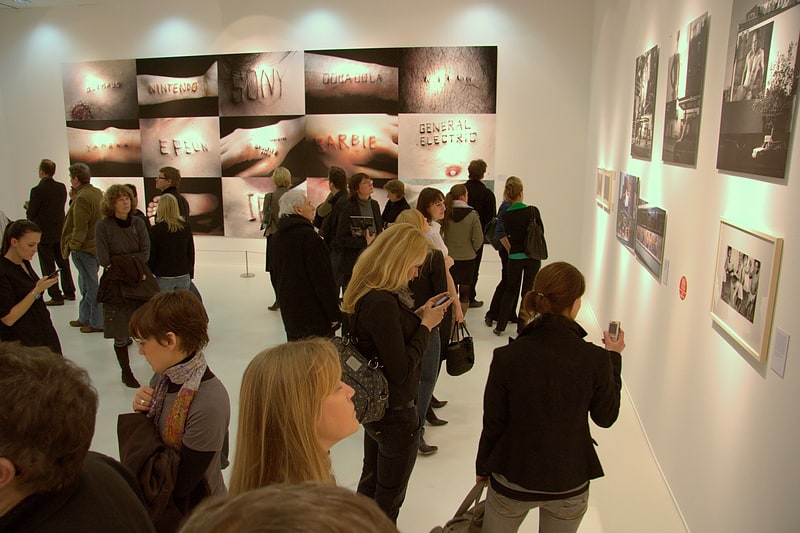
Also known as: NRW-Forum Düsseldorf
Museum in Düsseldorf, Germany. The NRW Forum Wirtschaft und Kultur, formerly the Museum für Industrie und Wirtschaft, is a museum in Düsseldorf, the state capital of North Rhine-Westphalia, dealing with the development and the economy of the state of North Rhine-Westphalia or regions within it, such as the Rhine-Ruhr-region. Today it is part of the Museum Kunstpalast.[10]
Address: Ehrenhof 2, 40479 Düsseldorf (Stadtbezirke 01)
Paul-Janes-Stadion
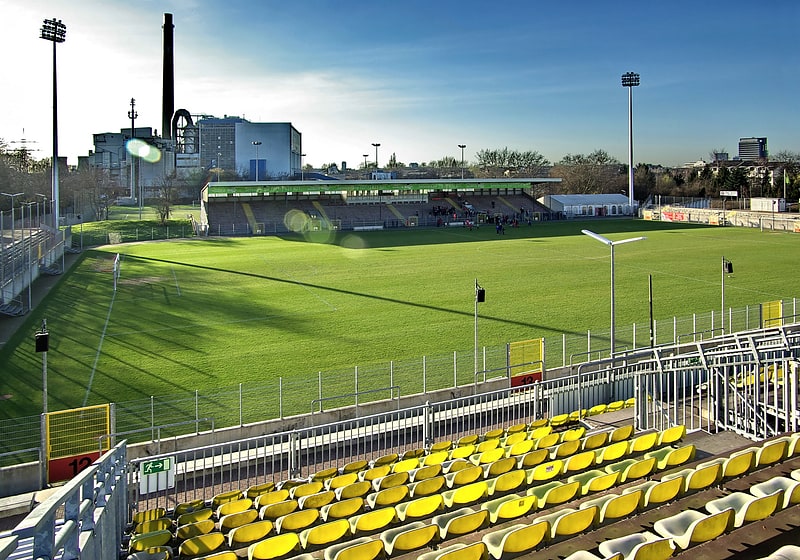
Stadium in Düsseldorf, Germany. The Paul-Janes-Stadion in Düsseldorf-Flingern is one of the home grounds of Fortuna Düsseldorf. It is located at 87 Flinger Broich, to the east of the city centre in the Nord Flingern district.
The stadium was built in 1930 by the team; now city-owned, it has been named since 1990 after the long-standing Düsseldorf and national football player Paul Janes. Before 1990 was it called "Flinger Broich" or "Fortunaplatz".
After World War II, the British army took over the stadium. A storm in 1958 destroyed the corrugated iron roof. In 1967 Fortuna Düsseldorf's clubhouse was built on the grounds.
While the Rheinstadion was under renovation in the 1970s, the Paul-Janes-Stadion was a Bundesliga ground, and appropriate floodlighting was therefore installed.
In 2001–02, the stadium was further renovated, to provide Fortuna with a satisfactory ground after the demolition of the Rheinstadion. New terraces were built and the grandstand was renovated. The renovations, financed by the City of Düsseldorf, cost €5 million. After the completion of the LTU Arena (now Esprit Arena), Fortuna Düsseldorf continued to play up to three home matches a year in Paul-Janes-Stadion, playing the remainder in the modern arena, until the 2007/2008 season, since when no further league matches have been played by the first eleven in the older stadium; it is now used exclusively for test, friendly, and cup matches and for all matches of the second eleven (Fortuna Düsseldorf II) and youth affiliate matches.
During the 2006 FIFA World Cup, the stadium was the venue for the biggest "Public Viewing" showing in a non-World Cup city in Germany. In addition to 12,600 seats for the fans in the stadium, there was a promenade around the stadium and an entertainment programme, particularly for children.[11]
Address: Flinger Broich 87, 40235 Düsseldorf (Stadtbezirke 02)
Kunsthalle Düsseldorf
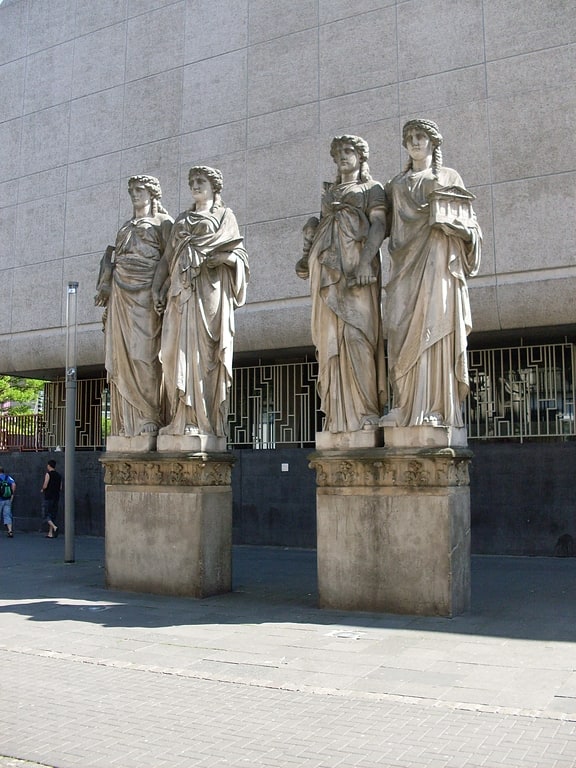
Modern art museum with tunnel gallery. Kunsthalle Düsseldorf is an exhibition hall for contemporary art in Düsseldorf.[12]
Address: Grabbepl. 4, 40213 Düsseldorf (Stadtbezirke 01)
Church of St. John
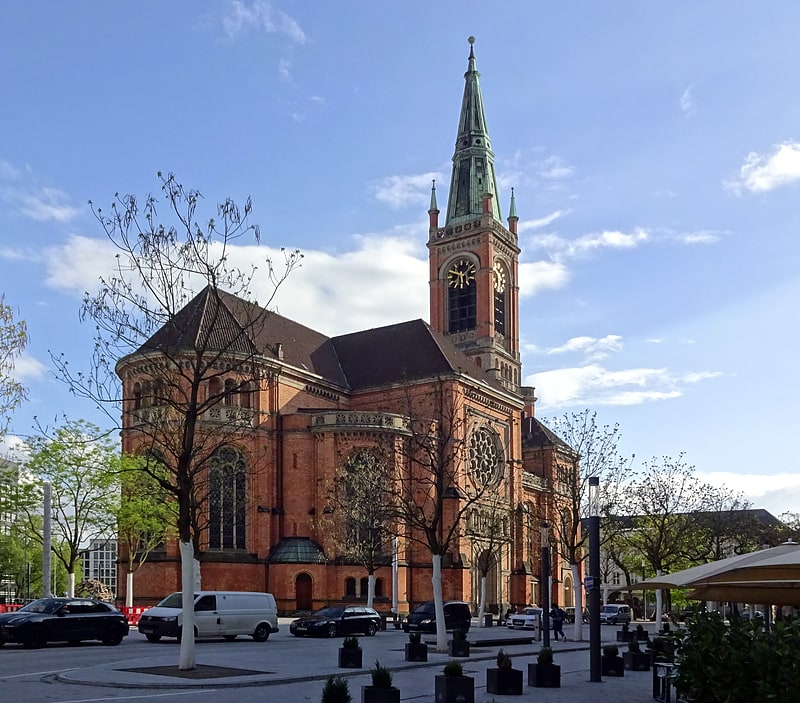
Also known as: Johanneskirche
Protestant church in Düsseldorf, Germany. St John's Church, with its almost 88 m high tower, is the largest Protestant church in Düsseldorf. It is located at the Martin-Luther-Platz. The church was built from 1875 to 1881 in the Romanesque Revival style. It was severely damaged in World War II, but was saved from destruction and in 1953 it was reopened. The last major remodeling took place in 2008. There is a cafe through which one enters the actual church.[13]
Address: Martin-Luther-Platz 39, 40212 Düsseldorf (Stadtbezirke 01)
Tonhalle Düsseldorf
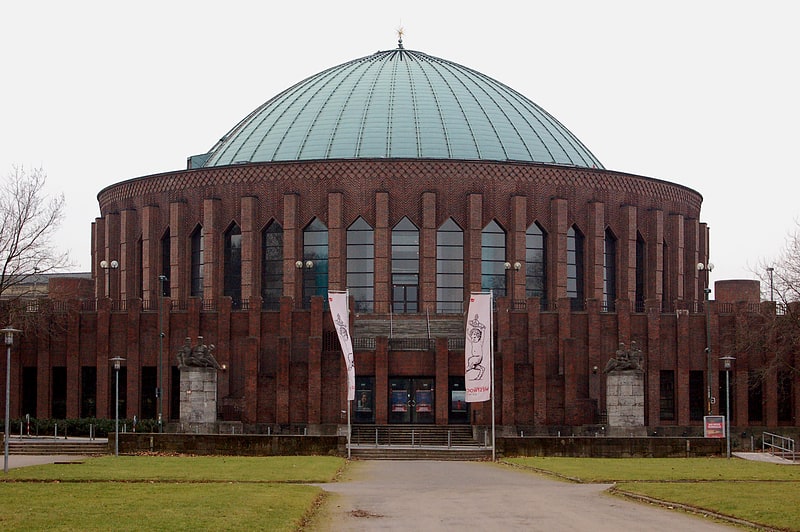
Concert hall in Düsseldorf, Germany. Tonhalle Düsseldorf is a concert hall in Düsseldorf. It was built by the architect Wilhelm Kreis. The resident orchestra, the Düsseldorfer Symphoniker, play symphonic repertoire at the Tonhalle as well as opera at the Deutsche Oper am Rhein.[14]
Address: Ehrenhof 1, 40479 Dusseldorf (Stadtbezirke 01)
City Museum

Museum, Specialty museum, History museum
Address: Berger Allee 2, 40213 Düsseldorf (Stadtbezirke 01)
Schloss Jägerhof
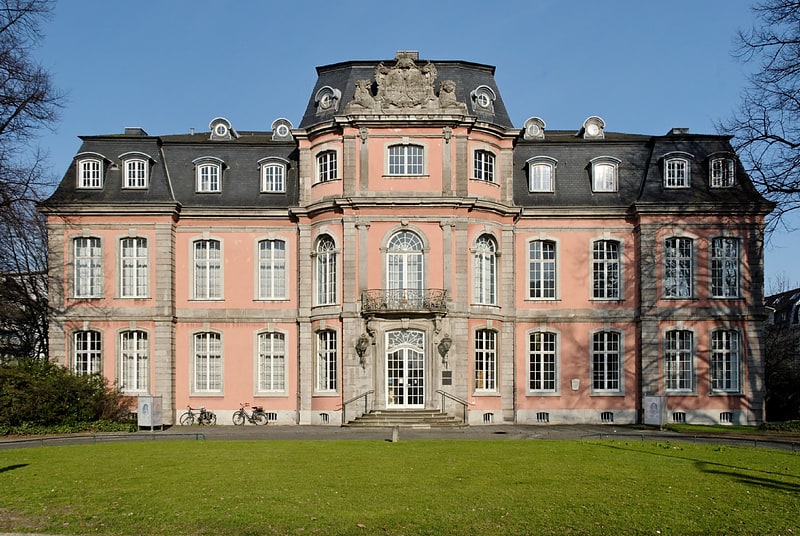
The Schloss Jägerhof, formerly also called die Vénerie, is located at Jacobistraße 2 in Düsseldorf-Pempelfort, near the city centre. It was built between 1752 and 1763 by order of the Prince-elector Karl Theodor. At that time, the castle was still located outside the city gates. The palace is a point de vue of the Hofgarten riding avenue and the Jägerhofstraße. Since 1987, the castle has housed the Goethe-Museum and the Ernst Schneider Foundation.[15]
Address: Jacobistraße 2, Düsseldorf (Stadtbezirke 01)
Komödie Düsseldorf
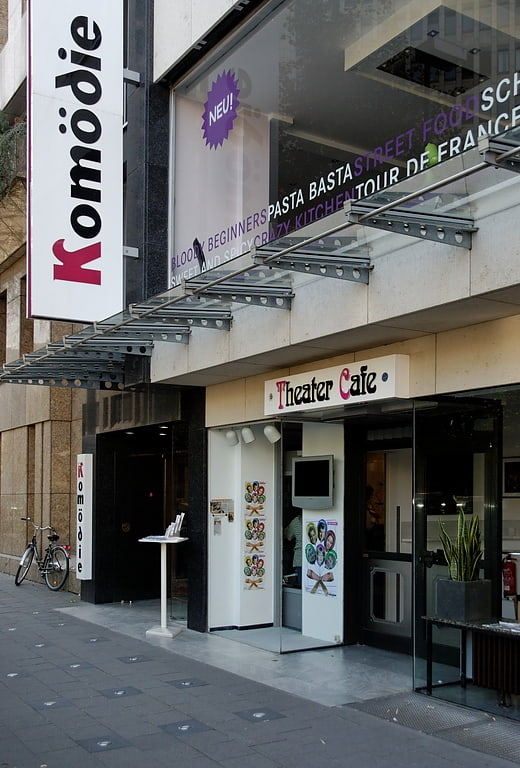
Theatre in Düsseldorf, Germany. Komödie Düsseldorf is a theatre in Düsseldorf, North Rhine-Westphalia, Germany.[16]
Mickeln House

Also known as: Schloss Mickeln
Building in Düsseldorf, Germany. Mickeln House is a manor house in Düsseldorf's Himmelgeist neighbourhood.
It was erected in 1843 on the site of Haus Mickeln, which went back to 1210. As that building had been destroyed in a fire in 1836, Herzog Ludwig von Arenberg used an insurance payment to have renowned architect Josef Niehaus rebuild the manor as a summer residence. Niehaus used engravings of villas built in the 16th century by Galeazzo Alessi as a template.
The manor has a square plan, each side measuring 19.55 metres. All perspectives are designed identically, apart from an outside staircase on the northern side. The entrance portal is surrounded by lime trees. That concept was already envisaged in 1843, when the surrounding gardens were designed by Maximilian Friedrich Weyhe. Some of the trees, e.g. plane trees, European Beech, and two Lebanon cedars, have survived; the last-named are considered one of Düsseldorf's natural monuments.
Since June 2000, the estate has been used as a conference centre and guest house by Düsseldorf University.[17]
Address: 25 Alt-Himmelgeist, Düsseldorf (Stadtbezirke 09)
Theatermuseum

Museum, Specialty museum
Address: Jägerhofstraße 1, 40479 Düsseldorf (Stadtbezirke 01)
Neanderkirche
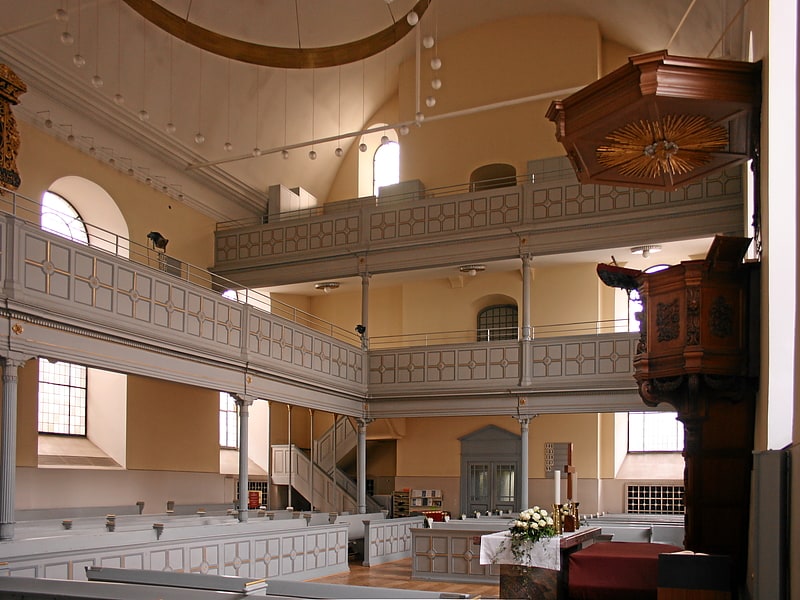
Building in Düsseldorf, Germany. The Neanderkirche is a Protestant church in the centre of Düsseldorf, the Altstadt. The building in early Baroque style was completed in 1687 and later named after the Reformed minister and hymn writer Joachim Neander. It is now a parish church of the Evangelische Kirchengemeinde Düsseldorf-Mitte. In 1965, a Rieger organ was installed, which is also used for a series of summer concerts.[18]
Address: Bolkerstrasse 36, 40213 Dusseldorf (Stadtbezirke 01)
Opernhaus Düsseldorf

Opera house in Düsseldorf, Germany. Opernhaus Düsseldorf is a venue and administrative headquarters of the Deutsche Oper am Rhein.
The original opera house was constructed between 1873 and 1875 as the Stadttheater Düsseldorf, designed by Ernst Giese (1832-1903). By its inauguration day, 29 November 1875, it was only partially completed due to cost overruns, but it continued to the operated by the city authorities. By 1891 an electric lighting system had been installed.
The auditorium contained a parquet level, 2 levels of seating plus a gallery, providing a total of 1,260 seats.
By 1921 the city had transferred the ownership of the theatre to the opera company and, in 1925, it was renamed as the Operhaus to distinguish it from another theatre then presenting operettas. After bombs in January and November 1943 during the Second World War destroyed much of the auditorium, some performances did proceed for several months in 1944, but in an auditorium reduced to 1,000 seats. By September 1944 all theatres were closed, and regular performances did not begin again until October 1945 with Bizet's Carmen.
In the post-war years major renovations began in 1954 to improve the temporary wartime repairs. Between 1954 and its reopening on 22 April 1956, the house was restored and inaugurated with a performance of Beethoven's Fidelio. The house now seated 1,342 people.
Also during this time the link between Düsseldorf and Duisburg was re-created in the form of a joint company, the German Opera on the Rhine.
Later in 1956, on 29 September, the company's premiere production of Richard Strauss’ Electra was given in Düsseldorf and, on 30 September, Verdi's Falstaff was presented in Duisburg.[19]
Address: 16A Heinrich-Heine -Allee, Düsseldorf (Stadtbezirke 01)
Düsseldorfer Schauspielhaus
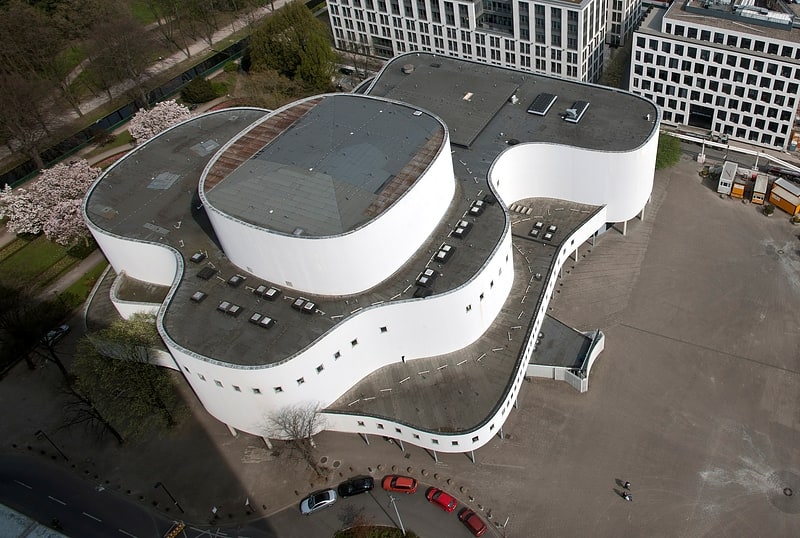
Theatre in Düsseldorf, Germany. The Düsseldorfer Schauspielhaus is a theatre building and company in Düsseldorf. The present building with two major auditoria was designed by the architect Bernhard Pfau and built between 1965 and 1969. It opened in 1970.[20]
Address: Gustaf Gründgens Platz 1, 40211 Düsseldorf (Stadtbezirke 01)
Komödchen

Theater in Düsseldorf, Germany. The Komödchen is a cabaret stage in Düsseldorf.
The Kom(m)ödchen was created in 1947 as a political-literary cabaret by Kay and Lore Lorentz. Other participants in the initial program "Positiv dagegen", which had its premiere on March 29, 1947, were Werner Vielhaber, Bernd Nesselhut, Hans Walter Clasen, Eduard Marwitz, Iris Fanslau, and Ruth Henrichs. Hanne Wieder was also part of the ensemble in its first year. In 1959 the television transmission of the program was banned for a year.
The theater moved to its present location on April 27, 1967, and its stage and props were moved to the new location by guests during the intermission of a performance.
In 1983, Lore Lorentz decided to pursue solo appearances and left the Kom(m)ödchen ensemble. Kay Lorentz stayed and continued to build a new ensemble. With his death in 1993, Lore gave up her solo career and returned to lead the Kom(m)ödchen. She gave the leadership to her son Kay S. Lorentz, who has continued since Lore's death in 1994.
The public square in front of the theater was renamed the "Kay-und-Lore-Lorentz-Platz" in their honor, and there is also a city school named the "Lore Lorentz Schule".
Well-known members of the ensemble have included Thomas Freitag, Harald Schmidt, Hugo Egon Balder, and Volker Pispers. The journalist and poet Thaddäus Troll wrote scripts for the cabaret in the early 1950s.[21]
Flehe Bridge

Also known as: Fleher Brücke
Cable-stayed bridge in Düsseldorf, Germany. The Flehe Bridge, is a single tower cable stayed bridge located in Düsseldorf, over the Rhine. It connects the A 46 motorway from the left bank of the Rhine with the Bergisches Land on the right bank and the south of Düsseldorf. It forms at the same time the southern part of the ring of motorways around Düsseldorf. It includes a pedestrian and cyclist strip.
This bridge opened in 1979 and eliminated a considerable amount of transit traffic south of Düsseldorf and the South Bridge (B 1), both then the only southern access from the left bank of the Rhine to Düsseldorf. Also, it connected the A 46 with the A 57. The Flehe Bridge has in each direction three vehicle lanes and a hard shoulder. The bridge does not cross the Rhine in a right angle, in order to preserve the area of water procurement of the old water company Flehe. A remarkable feature of the Flehe bridge is the reinforced concrete suspension tower, which looks like a Ypsilon turned on its head. In the handles of the pylons an elevator and stairs are accommodated above the roadway. The handles are in bridge longitudinal direction only 6.4 metres (21 ft) broad. They were manufactured with a climbing formwork. The 13-feldrige foreland bridge is a prestressed concrete construction work with a construction height of 3.80 metres (12.5 ft) and a total span of 13 by 60 metres (43 ft × 197 ft) = 780 metres (2,560 ft). thereby exists covers on a length of nine fields from two single-cell hollow boxes with ever 7.0 metres (23.0 ft) broad base plate. The remaining four fields within the range of the bridge removing possess against it a five-cellular box cross-section with base plate width of 29.5 metres (97 ft). A structural steelwork has the 368 metres (1,207 ft) river opening stretching far as if cover.[22]
Address: A 46, 41468 Düsseldorf (Stadtbezirke 03)
K21 Kunstsammlung NRW
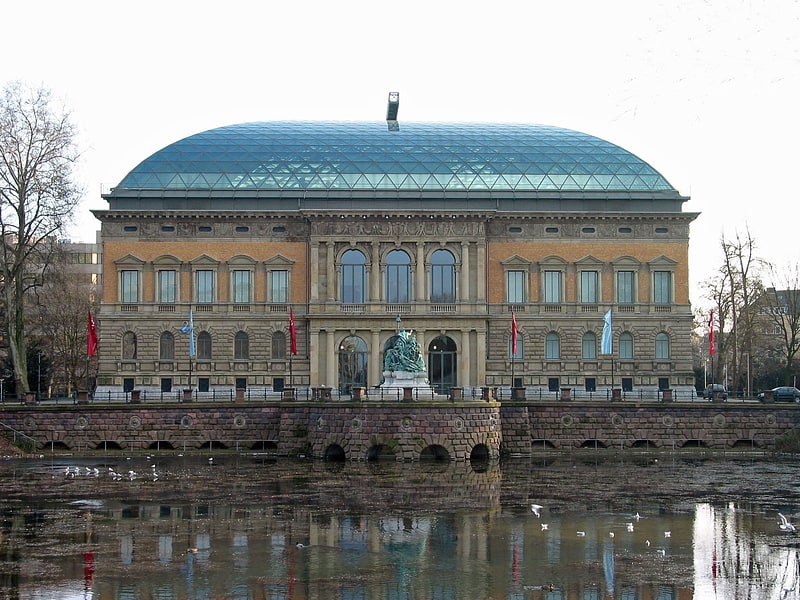
Museum, Art museum
Address: Staendehausstr. 1, 40217 Dusseldorf (Stadtbezirke 01)
Theodor Heuss Bridge

Also known as: Theodor-Heuss-Brücke
Bridge in Düsseldorf, Germany. The Theodor Heuss Bridge also known as the Nordbrücke is a cable-stayed bridge over the Rhine River in Düsseldorf built from 1953 to 1957 with a main span of 260 m flanked on either side by spans of 108 m.
It was the first cable-stayed bridge built in Germany. Along with two other cable-stayed bridges to the south, the Oberkassel Bridge and the Knie Bridge, the Theodor Heuss Bridge forms the central leg of Düsseldorf's family of bridges over the Rhine.
The bridge carries Bundesstraße 7, downtown connector to Autobahn 52. Growing traffic volume in the bridge relaxed in May 2002 due to the opening of the Airport Bridge to the north.[23]
Hamm Railway Bridge
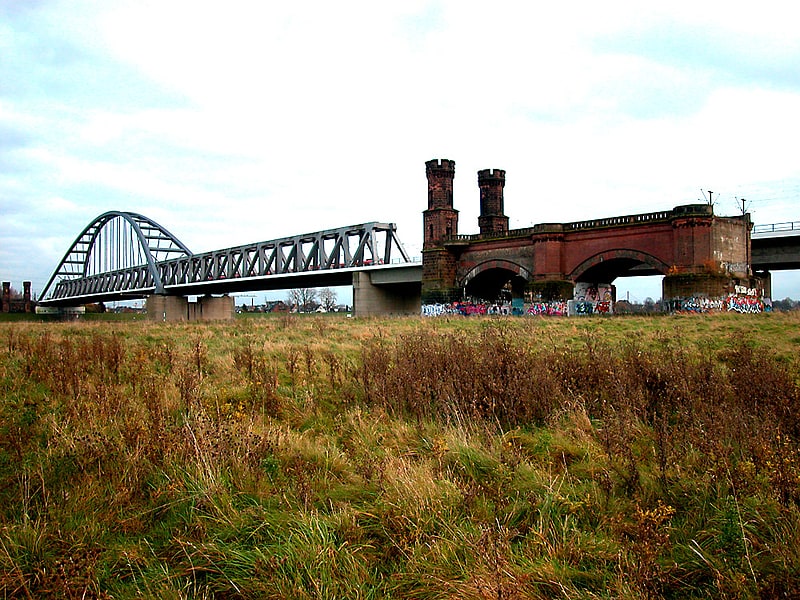
Also known as: Hammer Eisenbahnbrücke
Bridge in Düsseldorf, Germany. The Hamm Railway Bridge carries the Mönchengladbach–Düsseldorf railway over the Rhine between the Düsseldorf suburb of Hamm and the Neuss district of Rheinparkcenter in the German state of North Rhine-Westphalia.
The original Hamm Railway Bridge was a double-track bridge built by the Bergisch-Märkische Railway Company from April 1868 as the first solid bridge across the Rhine in Düsseldorf and was opened on 24 July 1870. It was named the König-Wilhelm-Brücke ("King William Bridge") or König-Wilhelm-Eisenbahn-Rheinbrücke (“King William railway bridge across the Rhine”) after the Prussian King William I. It was built as a wrought iron arch supporting a three-span truss to plans of the engineer Pichier of the Harkort Company (Harkort’sche Fabrik) of Duisburg. The bridge towers on both sides reflected not only a need for architectural decoration, but also a desire to promote the military security of the bridge in the event of a war. For the same reason there was an outer fort at the side of the bridge, which was removed in 1885. Between July and September 1896, the approaches to the bridge were repaired and the track body was renewed under traffic. The whole construction was carried out in heavy traffic with all traffic handled on a single track.
After 1896 the greatly increasing train traffic necessitated the building of additional infrastructure to complement the bridge. Between 1909 and 1911, a second, parallel, double-track bridge was built only 32 m upstream. It was built with the same distance between the piers, with a more modern and stronger superstructure as an iron truss arch. As with the older bridge there were bridge towers, but they were larger and stronger.
Immediately after the commissioning of the new bridge, the modernisation of old bridge began, with the half-parabolic beams being replaced with new superstructure, which were identical to those of the second bridge. After its completion in November 1912, there were two quasi-identical bridges next to each other, with only the bridge towers differing significantly.
During the Second World War, the U.S. Army conquered the neighbouring town of Neuss on 1 March 1945. To slow the advancing troops' crossing of the Rhine, the German Wehrmacht then blew up all the Rhine bridges in Düsseldorf, including the Hamm Railway Bridge, on 3 March 1945. Already in late 1945, temporary repairs began on the less damaged northern bridge, on which the two destroyed central arches were replaced by a temporary bridge made from standardised parts to the "Schaper-Krupp-Reichsbahn” design. Despite many difficulties, the bridge was already taken into operation on 31 July 1946. For the final reconstruction of the northern bridge, the least damaged arches of the identical southern bridge were substituted for the temporary spans; this exchange was completed in November 1947, removing the need for speed or weight restrictions. The ruins of the southern bridge were not rebuilt and the iron parts were used for scrap. The piers and bridge towers remain in a ruined condition.
The construction of the east–west S-Bahn line S 8 in 1984 required the building of a new railway bridge to restore the Hamm Railway Bridge to four tracks again. The cost of this amounted to the equivalent of €61.4 million. In this case, the span for the shipping channel was greatly expanded. The new bridge was built to the south of the original bridge.
The two-span river bridge has as its main span a 250 m long tied arch bridge attached to a through truss span built as a Warren truss with a span of 135 m. The construction is reminiscent of the historic structure. The bridge is designed so that two tracks are within the truss structure and a single track runs on both sides outside of the truss. The 9,000 tonne construction is fully welded. The bridge was built with heavy items of up to 100 tonnes built in an assembly area on the Düsseldorf bank and inserted in the final construction. The new bridge was opened in 1987 and had, until the opening of the Grümpentalbrücke (Grümpen Viaduct) on the Nuremberg–Erfurt high-speed railway with a 250-metre-long span, the longest railway bridge span in Germany. The old north bridge was then demolished and the bridge towers were left as a relic of the original bridge of 1870. The Bergische Lehnsritter e. V. club now has its headquarters in the towers.[24]
Apollo Varieté Theater
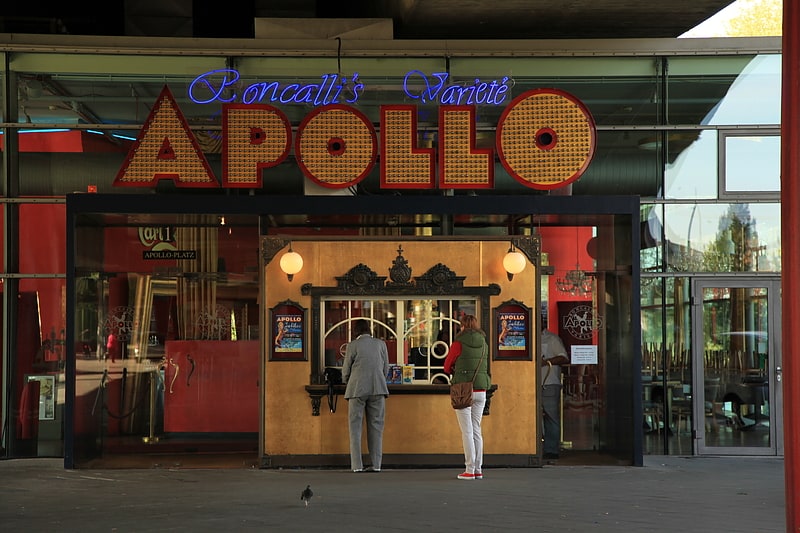
The Apollo Varieté is a vaudeville theater on the Rheinuferpromenade in Düsseldorf, in the immediate vicinity of the state parliament. Managed by Bernhard Paul and operated in the form of an event theater, the venue has hosted music, theater and variety events since opening in 1997.
Address: Apollo-Platz 1, 40213 Dusseldorf (Stadtbezirke 03)
Schlossturm

The castle tower stands on Burgplatz in Düsseldorf and is used as a maritime museum.
Address: Burgpl. 30, 40213 Düsseldorf (Stadtbezirke 01)
St. Andreas

Also known as: Andreaskirche
Parish church in Düsseldorf, Germany. The Church of St. Andreas is a Roman Catholic parish church situated in the center of the German city of Düsseldorf. It is the priory church of the local community of Dominican Friars, who also administer the much older Church of St. Lambert.[25]
Address: Andreasstraße 27, 40213 Düsseldorf (Stadtbezirke 01)
Stadttor
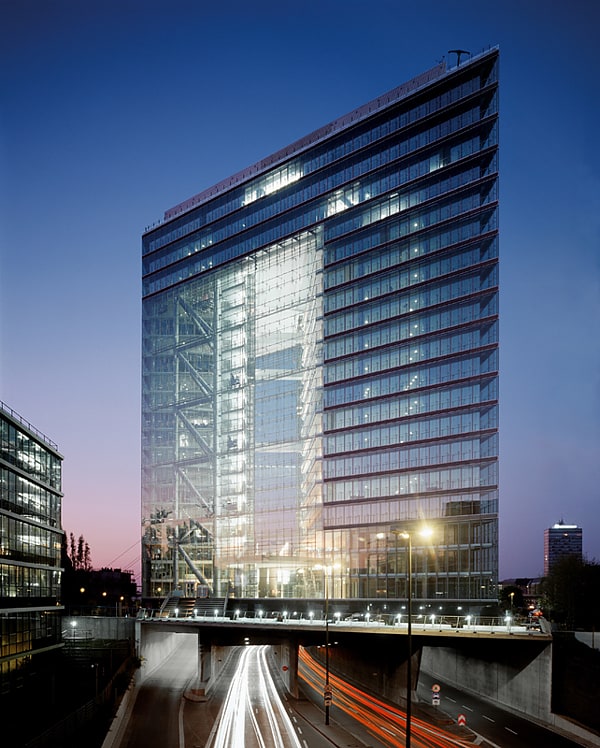
Skyscraper in Düsseldorf, Germany. Stadttor is a 20-storey 84 m high-rise building in the Unterbilk neighborhood of Düsseldorf, Germany. The building was designed by Düsseldorf-based architecture firm Petzinka Pink und Partner and completed in 1998. It marks the Southern entrance of Rheinufertunnel, which is also the reason for its parallelogram-shaped floor plan.
The building features a 15-story atrium and a double-facade, allowing natural ventilation even on higher elevation floors. The total gross floor area is some 30,000 m2 (320,000 sq ft). From 1999 until 2017, the Stadttor was the seat of the state-chancellery of the Prime ministers of North Rhine-Westphalia.[26]
Address: Stadttor 1, 40219 Dusseldorf (Stadtbezirke 03)
City Hall
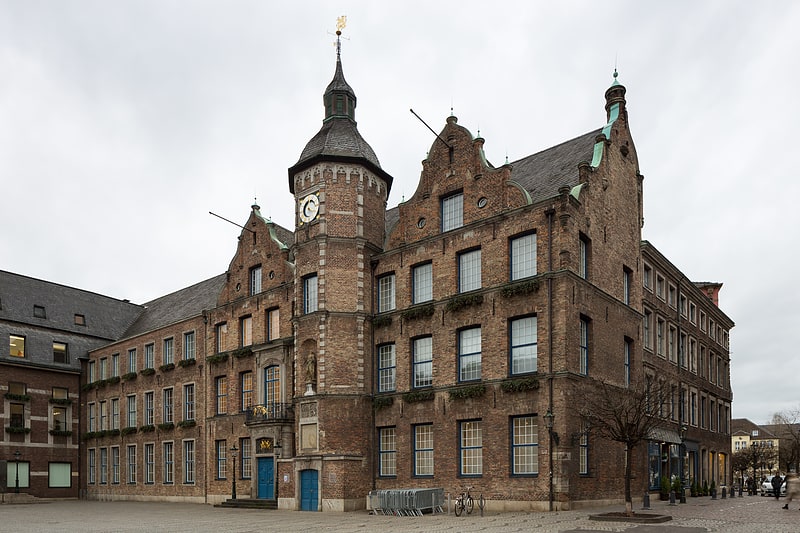
The history of the construction and use of the city hall of the state capital Düsseldorf dates back to 1570/73 in the oldest parts of the building. Since that time, the Düsseldorf City Hall, located in the middle of the old town and in the immediate vicinity of the Rhine, has continuously been the seat of the city council and the municipal administration. Until 1806, the oldest parts of the building, the old town hall, also served as a meeting place for the estates of the duchies of Jülich-Berg. The main entrance and the representative view are located on the market square enclosed by the town hall.
Address: 2 Marktplatz, Düsseldorf (Stadtbezirke 01)
Stahlhof
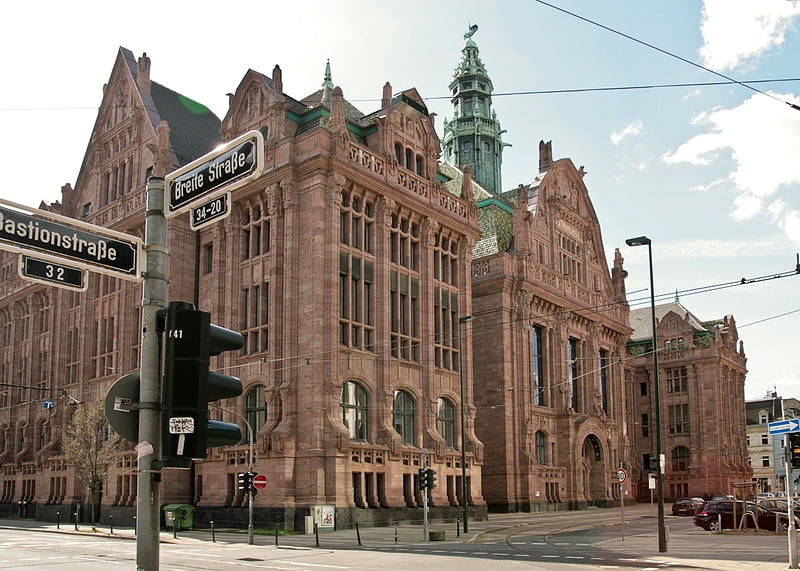
Tourist attraction in Düsseldorf, Germany. The Stahlhof at Bastionstrasse 39 in Düsseldorf, North Rhine-Westphalia, in Germany, is the seat of the Düsseldorf Administrative Court.[27]
Address: 39 Bastionstraße, Düsseldorf (Stadtbezirke 01)
Wilhelm-Marx-Haus
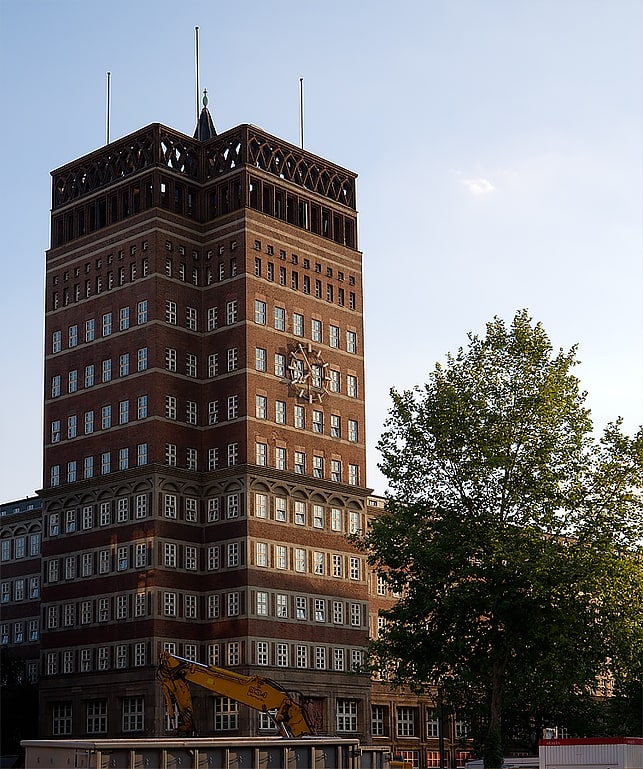
High-rise building in Düsseldorf, Germany. Wilhelm Marx House is a historical high-rise building in the central district of Düsseldorf in Germany. It was one of the first highrise buildings in Germany.
Wilhelm Marx House was finished in 1924 (beginning of the construction was in 1922) and was one of the first skyscrapers in Europe. It is 57 meters high and has 13 floors above ground level. The architect was Wilhelm Kreis.
It was named after Wilhelm Marx, who was mayor of Düsseldorf in the early 20th century and started a programme for the modernisation of the city in that time. This Wilhelm Marx is not the same person as the German Chancellor Wilhelm Marx.
The building was renovated in the 1990s.
Wilhelm Marx House was previously home of the Düsseldorf Stock Exchange and presently includes a theatre, called "JuTA" ("Junges Theater in der Altstadt", or "Young Theatre in the Old Town").[28]
Address: 53 Heinrich-Heine-Allee, Düsseldorf (Stadtbezirke 01)
New Synagogue

Also known as: Neue Synagoge
Synagogue in Düsseldorf, Germany. The New Synagogue is the synagogue of the Jewish community in Düsseldorf, Germany. The synagogue was built in the Golzheim district, far from the site of the former synagogue, which was located in the city center at Kasernenstraße. There the synagogue, built in 1905, was pillaged and burned by SA men during the Kristallnacht in 1938.
The synagogue is named after rabbi Leo Baeck, who served as a pulpit rabbi in Düsseldorf. It was inaugurated in September 1958. On 3 October 2000, the synagogue was firebombed. Since then, there is a constant police watch over the synagogue.[29]
Address: Zietenstrasse 50, 40476 Dusseldorf (Stadtbezirke 01)